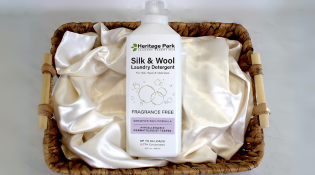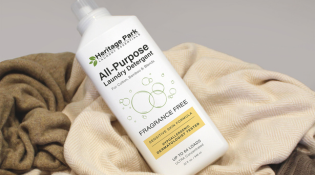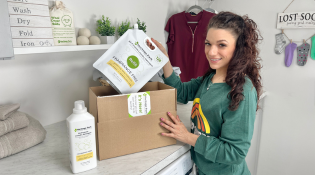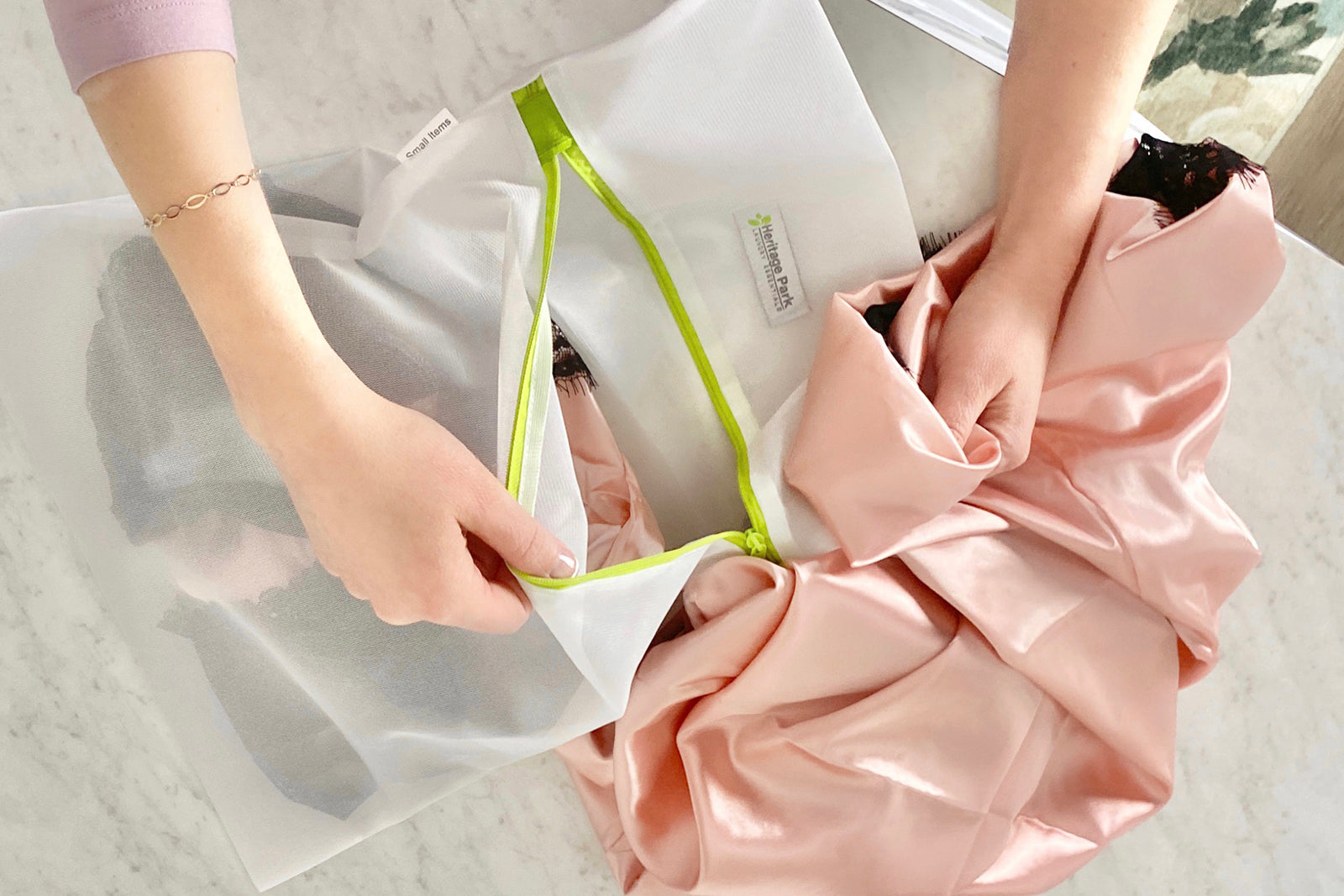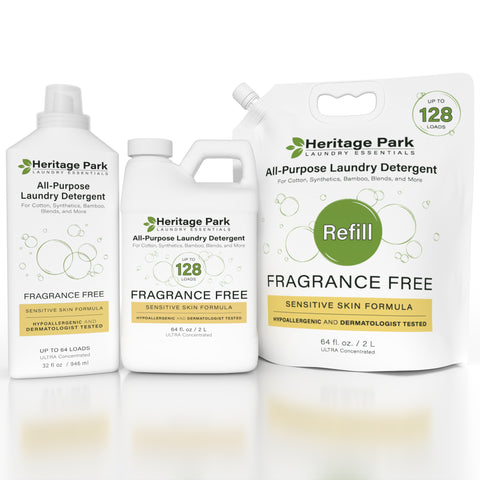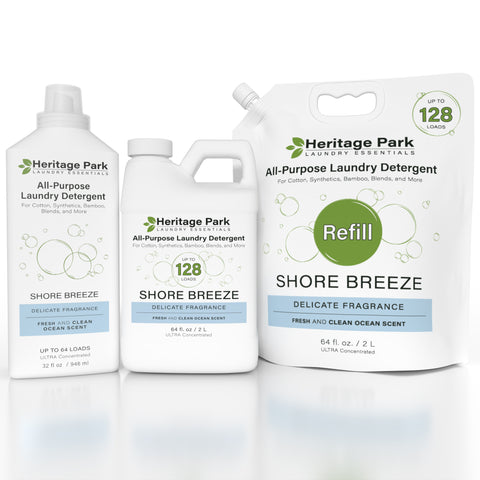Are you a bit baffled by the buttons and dials on your washer? If so, you're in good company. It's super easy to press "Normal" and "Auto-Fill" and walk away knowing your clothes will get (more or less) clean. But if you've done that -- no judgment here -- you're probably not getting top performance from your washing machine.
Inside this Article:
Heritage Park Laundry is here to help. Our goal is to make every aspect of laundry care easier for YOU. That's why we developed our fabulous line of gentle, effective laundry detergents and helpful accessories. Today, we're delivering simple strategies for mastering the settings on your washing machine. We'll show you what all the settings on your washing machine mean and how to select the correct washer cycle when laundering. After all, your washing machine is a big investment; read on to learn how to get top performance out of your machine and take great care of your clothes and linens. Laundry room success awaits!

Start By Reading Care Labels and Sorting
The first thing you need to do before laundering any item is to read the care label. Often overlooked, the symbols on the care label are the blueprint for washing your item; follow their recommendations! Next, sort your laundry using three variables:
- Color: Whites, darks, and bright colors should be separated into three piles.
- Weight/fabric type: heavier or bulky items (think towels or jeans) should not be washed with delicate fabrics. Along with requiring different wash cycles, the heavier items can damage or snag the delicates. Always use a mesh laundry bag to protect delicate items such as lingerie, swimsuits, or washable linen.
- Dirtiness: Wash heavily soiled items together in their own load.
Now is the time to pre-treat any stain according to the manufacturer's instructions.
Select Load Size and Water Temperature
Next, select your load size and water temperature. It's important not to overload your washer; whether you have a top loader or front loading washer, respect your washing machine capacity (usually measured by the cubic foot). Washing an oversize load is fine, as long as the machine can accommodate the large load size. Some washing machines "auto-select" load size for you to ensure clean laundry that is properly rinsed. Otherwise, a simple rule of thumb is to use a small load size for anything less than 1/3 full tub; medium for 1/3 to 1/2 full; large for ½ to 2/3 full; and extra-large or super for anything bigger.

Choose your wash water temperature following these basic guidelines:
|
|
Best for |
Example |
|
Cold Water |
Darks, colors that could run or fade, lightly soiled, delicate fabric |
Bright t-shirts, jeans, swimsuits, anything tie-dye, Lingerie, washable table linen |
|
Warm Water |
Permanent press, synthetic, lightly soiled items |
Colored towels, bed sheets, exercise clothing |
|
Hot Water |
Whites, heavily stained items |
White towels and bed linens. Items that can be bleached |
Using the wash right temperature is essential for both getting your clothing clean and stain removal (especially whites) while preventing items from fading or bleeding color. (If you've ever accidentally tossed a red t-shirt in with a white load, you know what we're talking about!) Most newer washing machines only allow selection of the wash temperature; the rinse cycle is cold to comply with environmental regulations regarding energy efficiency.
Selecting the Proper Wash Cycle
This is where washing machine settings get a bit confusing, partially because the labeling of wash cycles varies from brand to brand. And while washing machine manufacturers work to make the choices intuitive, it's good to have a bit of background before you start pushing buttons or rotating dials.
No matter the brand of your machine, your wash cycle generally consists of three phases: wash (or agitate, for top loaders with an impeller), rinse, and spin. The specific cycle you choose delivers the right combination of time and intensity for each of these phases. For instance, a "delicate" cycle will be shorter and gentler (less agitation during wash, less speed during spin) than normal or permanent press cycles.

Let's start by looking at the three popular cycles, a version of which is likely to be on your particular washing machine:
|
|
Best for |
Example |
|
Normal Cycle |
High-speed wash and rinse |
Default setting for everyday items that are light to moderately soiled; mixed loads of laundry; cotton |
|
Permanent Press* |
High-speed wash, slower rinse |
Polyester, blends, non-cotton items that are likely to wrinkle; jeans; durable exercise clothing |
|
Delicate Cycle |
Slower wash, slower rinse |
Lingerie, delicate exercise clothing; washable silk; any items that indicate gentle wash |
*A word about permanent press: This may be the most mysterious setting on your machine, particularly for anyone born after the mid-20th century. Permanent press is actually a throw-back term, used to describe the innovative fabrics developed in the 1950s; these "wash and wear" blends didn't require ironing, which was a time-consuming task in many households of the day. The permanent press cycle was made to help these fabrics stay wrinkle- and shrink-free with a slower rinse. And while stopping wrinkles may not be your primary concern, the permanent press cycle is a gentler option that's easier on your clothes and can help them look good and last longer.
Note: some washing machines simplify the process by auto-adjusting both temperature and wash speed based on the type of load. The settings on the dial itself specify whites/cotton, colors/permanent press, etc. In this case, the work is done for you and you need only select what you are washing.
Using Special Cycles and Settings
Now that we've covered the basics, let's take a look at some of the special cycles and settings you may see on your machine. Don't fret if your clothes washer doesn't feature all of these or if they are labeled differently; check your washing machine manual for more details (most manuals are also available online).
|
Setting |
Best For |
|
Bulky |
Use for heavier items like a heavyweight, high GSM towels or bedding. |
|
Eco-friendly / High Efficiency |
Uses less water or a shorter cycle to save energy. |
|
Extra Rinse |
Second rinse ensures all detergent etc. is removed, a good option for allergies or sensitive skin. |
|
Hand Wash |
Gentler than the delicate setting for the most fragile washable items (instructions to hand wash will be indicated on care label) |
|
Heavy Duty Cycle |
For heavily soiled, dirty, or muddy loads that need strong effort to clean and sturdy fabric that can handle a more aggressive cycle (think: muddy sports uniforms). May use hot water. |
|
Heavy Soil |
Similar to heavy duty, may use very hot water. |
|
Pre-Soak (top loaders) or Soak Cycle (front loaders) |
Use to give tough stains a chance to lift out of fabric, particularly when pre-treating with either spray stain removers, bleach, or oxygenated bleach. |
|
Quick Wash |
A short cycle for a small load of lightly soiled items. |
|
Rinse and Spin |
Use for items like swimsuits that don’t need “cleaning” but a simple rinse and spin. |
|
Sanitize |
For bedding, towels, clothing that require sanitizing, extra hot water. |
|
Spin Only |
For extracting extra water from items (for example, a heavy load of towels that didn’t quite spin long enough) |
Choosing the Right Detergent
Choosing the right detergent is essential for both cleaning and preserving the beauty of your clothing, towels, and washable linens. We recommend a neutral pH mild detergent that can clean effectively without the use of harsh chemicals, such as our line of liquid detergent formulas from Heritage Park Laundry Essentials. Our all-purpose detergent is specially formulated with enzymes to clean effectively, yet preserve the beauty and integrity of even the finest linen. Our silk and wool formula is ideal for gently cleaning natural fibers. Heritage Park Laundry Detergent is biodegradable and made without phosphates (optical brighteners), chlorine bleach, or caustic chemicals.
More Tips For Laundry Success
As always, we make the following recommendations for ongoing laundry success:
- Always read care labels prior to washing. (You may discover an item requires dry cleaning!).
- Read the manual for your clothes washer. We realize this may not be your idea of riveting reading, but it's a good idea to at least familiarize yourself with all the features and everything your washing machine can do.
- Use bleach judiciously following both fabric care guidance and the instructions on your machine (which may have a special compartment for adding bleach).
- Avoid using fabric softener (and dryer sheets). These items create a filmy buildup on your clothing and can make your towels significantly less absorbent. We far prefer using wool dryer balls to tame static and shorten dry times.
- Never overload your machine or use too much detergent.
Heritage Park Laundry Essentials
At Heritage Park, caring for fine fabric is our passion. As lifelong collectors of luxury sheets, towels, and cloths, we found many commercially available "gentle detergents" either damaged our fabrics or didn't get the job done, leaving stains. We knew we could do better. So we developed a formula with the perfect balance of powerful -- yet safe -- ingredients designed to remove tough, set-in stains while remaining gentle on luxury linens. Please connect with us at (800) 977-1841 or visit our store or email us with any product feedback or cleaning questions.


